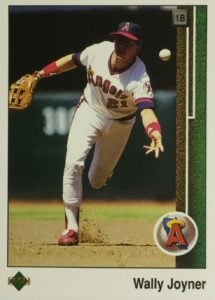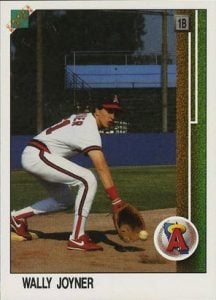Revisiting Upper Deck’s 1988 Promo Baseball Cards

Contents
Upper Deck changed the landscape of baseball card collecting forever in 1989. Debuting a slick look and, more importantly, $1.00 packs, the cards were highly sought after. Those $1.00 packs, too, forced other trading card companies to up their games — and ultimately, their prices.
While 1989 marked the beginning of Upper Deck’s baseball cards, a pair of early-released promo cards mark the company’s origins.
1988 Upper Deck Promo Card Origins
If you glance on eBay, you will find all sorts of advertised ‘promo’ cards released by Upper Deck in 1989. Those include black and white cards, blank-backed other cards, and cards with other such oddities. But when most talk about the first Upper Deck promo cards, they are usually referencing two very specific cards.
Upper Deck rolled out an extensive marketing campaign to advertise their 1989 cards. And one of their pre-set marketing pieces was a two-card promotional set featuring two California Angels cards. The players featured included young star Wally Joyner and relief pitcher DeWayne Buice.
The cards are technically promotional cards for Upper Deck’s 1989 set. However, they were first distributed in 1988 at the National Sports Collectors Convention. Thus, they are promotional cards for an 1989 release that were actually printed a year earlier.
But what about those player selections? Well, first we’ve got to start with the team choice.
Why the California Angels? After all, the team had not been very good. In 1987, they finished tied for last in the AL West with a 75-87 record. In 1988, they finished 4th in their Division but still had the same 75-87 record. But the reason for the Angels’ selection was probably two-fold. First, Upper Deck was headquartered in California. And second was the involvement of Buice, which ties into the player selections.
The choice to include Joyner would have been an easy one. Joyner had long been touted as the future of the team and he quickly showed promise. He finished second in the Rookie of the Year voting in 1986 to Jose Canseco. Joyner was also an All-Star that year and had an even better sophomore campaign. That year, he clubbed a career-best 34 home runs while driving in 117 runs. He wasn’t only the star of the Angels but one of the biggest young stars in all of baseball. While his career had a fast start, Joyner would never be able to replicate the type of success of those first two seasons, even though he lasted 16 years in the majors and was a career .289 hitter.
Despite Joyner not living up to the lofty expectations surrounding him early on, he was a clear candidate for the set. But why Buice? Buice made connections at Upper Deck and quickly got involved in the team’s effort to get a license to produce major league cards. He actually became a partner in the company, making the use of him for one of the promo cards a logical choice.
Without his involvement at Upper Deck, Buice likely would not have been a target for the set. He was only a rookie in 1987, though he showed some promise with 17 saves for the team. But his career wouldn’t last long and he was out of the majors after the 1989 season with a 9-11 career record. In 1988, the Angels had many other key players that could have been used, including young star Devon White, .300 hitter Johnny Ray, or staff ace Mike Witt.
The Design and Differences


At first glance, the cards look mostly like Upper Deck’s regular 1989 cards. However, upon a closer inspection, it’s easy to see some differences.
For one thing, while Buice’s picture used was the same, the picture of Joyner features him fielding a grounder as opposed to his image in the regular set showing him tossing a baseball. To the design, the Upper Deck logo appears in the upper left on the front of the cards as opposed to the bottom left. Fronts also put the player names in all capital letters while the regular cards capitalized only the first letter. On the back, there are even more differences.
There are no MLB logos on the promo cards since the company had not yet secured their license by the time they were printed. Backs also do not include any biographical text description and the stats are formatted slightly differently. The numbers on the promo cards were different than the regular set, too. Buice was No. 1 while Ken Griffey, Jr. was the first card in the full set. Joyner was given No. 700 on his promo card but he was No. 573 in the set. But possibly the biggest differences on the backs are the holograms. Those holograms make for three different variations of each card.

Variations

While regular 1989 Upper Deck cards have a baseball diamond-shaped hologram at the bottom, Upper Deck experimented with the use of the hologram on the promo cards. The most common variations have a slim hologram at the bottom center but a slightly different variant has a larger hologram in that area that extends to the bottom border of the card.
The third variation is the toughest, and has the hologram at the top of the card backs instead.
Rarity and Pricing
Considering their importance in preceding one of the landmark baseball card sets of all time, it would be easy to understand if these cards were quite valuable. But like many things in the junk wax era, the cards are not terribly difficult to locate. They are not as commonplace as the regular 1989 cards, of course, but it is a bit of a stretch to consider them rarities. At any given time, eBay generally has several copies of each player available.
Near mint raw copies of either card typically starts around $10-$15, though Joyner asking prices can be slightly higher at times. Even in high-grade professionally slabbed examples, the prices are not too outlandish considering their importance. A PSA 10 of Buice, for example, recently sold for about $145 on eBay.
It should be noted, however, that savvy dealers that understand the rarity of the third rare type of the cards (with the holograms at the top) will often ask higher prices for those. But if you’re just looking or any example of the cards, those with the holograms at the bottom are extremely affordable.





